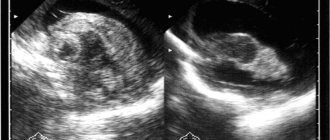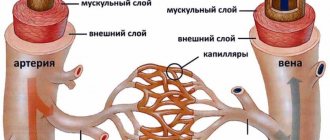Essence and etiology of RCN
Residual cerebroorganic insufficiency (RCI) is considered as residual manifestations arising from damage to the central nervous system.
This can occur during the perinatal (peripartum), childbirth, or infancy period. Official medicine cannot provide an absolutely accurate substantiation of the causes of such a pathology as cerebral insufficiency.
However, risk factors have been identified that increase the risk of developing RCN. These include:
- late pregnancy (woman’s age – 40 years or more);
- infection of the expectant mother with one or another virus (especially if this happened in the first trimester, when the developing fetus is most vulnerable);
- living of a pregnant woman in unfavorable environmental conditions;
- a pregnant woman being in a state of constant stress or depression;
- heavy physical labor during pregnancy;
- attempts to terminate pregnancy;
- premature birth;
- the expectant mother abuses alcohol, takes drugs, smokes;
- placental abruption, which provokes impaired cerebral circulation and oxygen starvation of the fetus;
- injury to the child during childbirth;
- head injuries received by the child after birth;
- introduction of a drug into the mother’s body for the effect of anesthesia during surgical interventions, including during caesarean section;
- immunological incompatibility between the mother and the child she is carrying.
Cerebral insufficiency syndrome can also manifest itself as a hereditary pathology.
A pediatric neurologist can diagnose such a deviation. If you do not start treating a child at an early age, the pathology will progress and the severity of symptoms will become more pronounced. Dealing with RCN is not easy. The child will need not only medical help, but also support from parents, teachers, and psychologists.
Causes of neurological diseases in children
The development of neurological diseases in children under one year of age is usually associated with the peculiarities of the intrauterine development process. Experts name the most common reasons:
- the child receiving a mechanical injury to the spine or brain during childbirth;
- oxygen starvation (hypoxia) of the fetus, which occurs for various reasons, for example, due to repeated entanglement of the umbilical cord around the neck;
- the complex process of childbirth and labor, which leads to infection of the birth canal, an increase in the anhydrous gap, the development of inflammatory complications, bleeding during or after childbirth;
- acute toxicosis of pregnant women throughout the entire period;
- genetic inheritance.
As for children over 1 year old, the root of neurological pathologies should be looked for in:
- low immunity and persistent infectious diseases of the child;
- frequent stress, depression;
- misuse of certain medications, such as antibiotics, anti-inflammatory drugs, corticosteroids;
- excessive stress on the body – physical and mental;
- being in constant fear and depression caused by the behavior of parents and peers at home, in kindergarten, school, clubs and sections;
- excessive emotionality of the child;
- unfavorable environmental conditions;
- diseases of the brain, internal organs, injuries.
Whatever the causes of neurological diseases in children, it is important to promptly detect disorders and begin treatment. The sooner this happens, the less likely it is to develop serious complications and the better the prognosis for recovery.
Manifestations of cerebral insufficiency in children
The clinical picture of RCN and its severity depend on the location of the affected area of the brain.
Residual cerebral insufficiency in children is expressed in the following symptoms:
- emotional instability, the child is overly irritable, capricious, his mood changes at lightning speed, parents often lose sight of this symptom, attributing it to characteristics of age.
- rapid fatigue, which occurs even with minor loads, including intellectual ones.
- The child grinds his teeth in his sleep and often wakes up.
- passivity, drowsiness, complaints of headaches and weakness;
- the child’s sensitivity to changes in weather conditions, that is, weather dependence; children experience surges in blood pressure, increased heart rate and even fainting;
- non-standard facial expressions: trembling of eyelids and lips, frequent blinking, twitching of shoulders;
- nervous tic;
- intolerance to noise, loud and harsh sounds, too bright light;
- intolerance to travel in any type of transport, the child feels nausea, even vomiting, lightheadedness;
- The extremities of a child diagnosed with RCON are often cold, no matter how warm it is indoors or outdoors, and the skin may acquire a marbled tint.
Separately, motor disorders should be noted as a clear symptom of cerebral insufficiency. They can be expressed either in inhibition, or, conversely, in impulsiveness and hyperactivity.
The first mentioned state manifests itself in passivity, slowness, and rapid fatigue, the second - in restlessness, excitability, and the need for active pastime. It is difficult to attract hyperactive children to quiet activities: even getting them to sleep is hard work.
You can suspect RCN in a school-age child if he cannot copy individual elements according to the provided model, or misses letters or entire syllables when reading.
In addition, there are also external signs of cerebral insufficiency in the child. This:
- the upper jaw is excessively pushed forward;
- skull deformations;
- wide-set eyes.
Children with RCN often become depressed, behave aggressively, and also throw tantrums. They have a poor appetite. Sometimes phenomena such as increased sweating, convulsions, and chills may be observed.
List of neurological diseases in children
The list of neurological diseases in children is quite impressive, so we will limit ourselves to listing the most common ones.
- Epilepsy. The disease manifests itself by sudden, recurring convulsive attacks.
- Cerebral palsy . The disease is characterized by limited motor capabilities of the child, difficulties in maintaining an upright posture and walking. Often accompanied by reduced intelligence, delayed speech development and epilepsy.
- Neurosis (psychoneurosis, neurotic disorder) . This name unites a group of reversible disorders, which are characterized by obsessive, asthenic or hysterical manifestations, weakening of both mental and physical performance.
- Hyperactivity . The disease manifests itself in the child’s excessive energy and mobility, impaired attention and sleep, lack of appetite, anxiety and some bad habits, for example, the habit of biting nails.
- Asthenic syndrome . Often occurs as a consequence of traumatic brain injury. It manifests itself as rapid fatigue, irritability, isolation and self-doubt, or a complete loss of the ability to perform physical activity for a long time.
Consequences of uncontrolled development of pathology
If cerebral insufficiency syndrome is not subjected to complex treatment, this may subsequently result in the following complications:
- slow development of the speech apparatus;
- difficulties in developing reading, writing, and counting skills;
- articulatory deviations;
- easily developing dependence on toxic substances and alcohol.
Due to the slow process of mastering speech skills, the child will experience communication difficulties, and due to behavioral deviations, it will not be easy for him to join the team. As a result, “provocateur” situations will arise that incline the child to depression and isolation.
Mental development delays in children and principles of their correction (review)
The mental development of a child is a complex, genetically determined process of sequential maturation of higher mental functions, realized under the influence of various environmental factors. The main mental functions include: gnosis (recognition, perception), praxis (purposeful actions), speech, memory, reading, writing, counting, attention, thinking (analytical and synthetic activity, the ability to compare and classify, generalize), emotions, will, behavior, self-esteem, etc.
V.V. Lebedinsky (2003) identifies six main types of mental development disorders in children:
- Irreversible mental underdevelopment (oligophrenia).
- Delayed mental development (reversible - fully or partially).
- Damaged mental development - dementia (the presence of a previous period of normal mental development).
- Deficient development (in conditions of visual impairment, hearing impairment, somatic pathology).
- Distorted mental development (early childhood autism).
- Disharmonious mental development (psychopathy).
Mental development delays in children and their correction are an urgent problem in pediatric psychoneurology. The term “mental retardation” was proposed by G. E. Sukhareva back in 1959. Mental retardation (MDD) is understood as a slowdown in the normal rate of mental maturation compared to accepted age norms. ZPD begins in early childhood without a previous period of normal development, is characterized by a stable course (without remissions and relapses, unlike mental disorders) and a tendency to progressive leveling as the child grows older. You can talk about mental retardation until primary school age. Persistent signs of underdevelopment of mental functions at an older age indicate oligophrenia (mental retardation).
Conditions classified as mental retardation are part of the broader concept of “borderline intellectual disability” (Kovalev V.V., 1973). In the Anglo-American literature, borderline intellectual disability is partly described within the framework of the clinically undifferentiated syndrome “minimal brain dysfunction” (MMD).
The prevalence of mental development delays among the child population (as an independent group of conditions) is 1%, 2% and 8–10% in the general structure of mental illnesses (Kuznetsova L. M.). Mental development delays as a syndrome are naturally much more common.
The pathogenesis of ZPR is poorly understood. According to Pevser (1966), the main mechanism of mental retardation is a violation of maturation and functional failure of younger and more complex brain systems, related mainly to the frontal regions of the cerebral cortex, which ensure the implementation of creative acts of human behavior and activity. There are currently no uniform forms of systematically borderline forms of intellectual disability. The most detailed classification of borderline states of intellectual disability presented by V. V. Kovalev (1973).
There is a division of ZPR into primary and secondary. In this case, secondary mental retardation occurs against the background of a primary intact brain in chronic somatic diseases (heart defects, etc.) accompanied by cerebral insufficiency.
In the first years of life, due to the immaturity of the nervous system, children often experience dysfunction in the maturation of motor and general mental functions. Therefore, usually in early childhood we are talking about a general delay in psychomotor development with a greater severity of mental function lag.
In children over three years of age, it becomes possible to identify more defined psychoneurological syndromes. The main clinical signs of mental retardation (according to M. Sh. Vrono) are: delayed development of basic psychophysical functions (motor skills, speech, social behavior); emotional immaturity; uneven development of individual mental functions; functional, reversible nature of the disorders.
If intellectual disability in preschool age is masked by speech disorders, then at school age it manifests itself clearly and is expressed in a poor supply of information about the environment, the slow formation of concepts about the shape and size of objects, difficulties in counting, retelling what has been read, and a lack of understanding of the hidden meaning of simple stories. In such children, a concrete-figurative type of thinking predominates. Mental processes are inert. Exhaustion and satiety are expressed. The behavior is immature. The level of visual-figurative thinking is quite high, but the abstract-logical level of thinking, inextricably linked with inner speech, turns out to be insufficient.
V.V. Kovalev distinguishes intellectual disability resulting from defects in analyzers and sensory organs in cerebral palsy and early childhood autism syndrome as separate forms of intellectual disability.
ZPR syndrome is polyetiological, the main reasons are:
1) perinatal lesions of the central nervous system (hypoxic-ischemic, traumatic, infectious, metabolic; alcohol and other fetopathies); 2) epilepsy and epileptic encephalopathies; 3) hydrocephalus (including hyporesorptive disorders); 4) craniostenosis; 5) brain tumors; 6) malformations of the brain (dysgenesis of the corpus callosum, holoprosencephaly, arachnoid cysts, etc.); 7) hereditary diseases (phenylketonuria, histidinemia, homocystinuria, etc.); mitochondrial diseases; 9) storage diseases; 10) chromosomal diseases (Down syndrome, fragile X chromosome, etc.); 11) hereditary syndromes; 12) neurocutaneous syndromes (neurofibromatosis, tuberous sclerosis, encephalotrigeminal angiomatosis, etc.); 13) congenital endocrine diseases (congenital hypothyroidism, etc.); 14) autistic disorders (Kahner's syndrome, Asperger's, Rett's syndrome, etc.); 15) somatic pathology (heart disease, kidney disease, etc.); 16) decreased visual and auditory function; 17) pedagogical neglect.
2) epilepsy and epileptic encephalopathies; 3) hydrocephalus (including hyporesorptive disorders); 4) craniostenosis; 5) brain tumors; 6) malformations of the brain (dysgenesis of the corpus callosum, holoprosencephaly, arachnoid cysts, etc.); 7) hereditary diseases (phenylketonuria, histidinemia, homocystinuria, etc.); mitochondrial diseases; 9) storage diseases; 10) chromosomal diseases (Down syndrome, fragile X chromosome, etc.); 11) hereditary syndromes; 12) neurocutaneous syndromes (neurofibromatosis, tuberous sclerosis, encephalotrigeminal angiomatosis, etc.); 13) congenital endocrine diseases (congenital hypothyroidism, etc.); 14) autistic disorders (Kahner's syndrome, Asperger's, Rett's syndrome, etc.); 15) somatic pathology (heart disease, kidney disease, etc.); 16) decreased visual and auditory function; 17) pedagogical neglect.
Over the course of the last decade, a natural connection between cognitive developmental disorders and epilepsy and epileptic activity in the brain has been identified. Epileptiform discharges in the EEG are quite widely observed in individuals who have never had epileptic seizures. Uncontrolled spread of spontaneous epileptic discharges with cascade-like involvement of potentially normal neurons in pathological synchronization outside of seizures leads to their inability to perform normal functions, which is manifested by the entire spectrum of cognitive disorders.
According to many studies, epileptiform activity is observed in the EEG of patients with cognitive impairment from 20% to 90%, depending on the form of pathology. Thus, a large area of overlap between mental development disorders and phenotypes with epileptiform and epileptic activity in the EEG has been identified. Accordingly, the Working Group on Classification and Terminology of the International League Against Epilepsy introduced the heading “Epileptic encephalopathies” into the draft new classification of epileptic syndromes, which includes epilepsies and epileptic syndromes in which epileptic discharges in the brain lead to progressive brain dysfunction. The drug of first choice in the treatment of cognitive epileptic disorders is valproic acid.
Assessment of a child’s mental development includes:
1) pre-speech and speech development; 2) development of perception (ideas about parts of the body, household objects, color, size, shape, orientation in space); 3) memory development (poems, retellings); 4) development of thinking (knowledge about the world around us - time of year, time of day; analytical and synthetic activity, ability to compare, generalize, classify); 5) development of attention (stability, switchability); 6) development of gaming activities; 7) development of visual activities (drawing, modeling) and design (buildings, etc.); development of self-care skills (hygiene skills, neatness, dressing/undressing, eating, etc.); 9) formation of the emotional-volitional sphere (stability of feelings and actions, responsibility, criticality of one’s behavior, self-regulation of behavior); 10) communicative development (contact and adequacy of behavior in communicating with others: the child’s interest in an adult, the ability to attract the attention of an adult, reaction to the adult’s attitude); 11) development of self-awareness (knowledge about oneself - name, surname, address; self-esteem, self-regulation of behavior); 12) development of school skills (counting, reading, writing, etc.).
2) development of perception (ideas about parts of the body, household objects, color, size, shape, orientation in space); 3) memory development (poems, retellings); 4) development of thinking (knowledge about the world around us - time of year, time of day; analytical and synthetic activity, ability to compare, generalize, classify); 5) development of attention (stability, switchability); 6) development of gaming activities; 7) development of visual activities (drawing, modeling) and design (buildings, etc.); development of self-care skills (hygiene skills, neatness, dressing/undressing, eating, etc.); 9) formation of the emotional-volitional sphere (stability of feelings and actions, responsibility, criticality of one’s behavior, self-regulation of behavior); 10) communicative development (contact and adequacy of behavior in communicating with others: the child’s interest in an adult, the ability to attract the attention of an adult, reaction to the adult’s attitude); 11) development of self-awareness (knowledge about oneself - name, surname, address; self-esteem, self-regulation of behavior); 12) development of school skills (counting, reading, writing, etc.).
To study the level of mental development of a child, psychological tests are used (Bayley scale, Denver test and many others). The level of intelligence according to the IQ system is determined in children over 3 years of age.
In ICD-10, mental disorders are discussed in section F80-F89 “Psychological developmental disorders”, and the following main headings are used:
- F80. Specific developmental disorders of speech and language (F80.0. Specific articulation disorder; F80.1. Expressive language disorder; F80.2. Receptive language disorder).
- F81. Specific developmental disorders of learning skills (F81.0. Specific reading disorder (dyslexia); F81.1. Specific spelling disorder (dysgraphia); F81.2. Specific disorder of arithmetic skills (dyscalculia); F81.3. Mixed disorder of learning skills; F81 8. Other disorders of learning skills).
- F82. Specific disorders of the development of motor functions (dyspraxia).
- F83. Mixed specific mental development disorders.
ZPD is often accompanied by conditions reflected in section “F90-F98” of ICD-10 “Emotional disorders and behavioral disorders beginning in childhood and adolescence” (F90. Hyperkinetic disorders: F90.0. Impairment of activity and attention; 90.1. Hyperkinetic behavior disorder ; F91. Behavioral disorders; F93.1. Phobic anxiety disorder; F95. Tics; F98.0. Enuresis of inorganic nature; F98.1. Encopresis of inorganic nature; F98.5. Stuttering, etc.).
The treatment of mental retardation is based on a multidisciplinary approach with the active participation of neurologists, pediatricians, psychologists, psychiatrists, speech therapists, and speech pathologists (including Montessori teachers). The correction must be carried out over a long period of time. The main direction of helping children with mental retardation is a comprehensive psychological and pedagogical correction aimed at improving cognitive development and the emotional-communicative sphere. If it is insufficiently effective, drug therapy is used. In this case, drugs with a nootropic effect (from the Greek noos - thinking, mind, intellect; tropos - turn, direction) become the drugs of choice. According to WHO definition, nootropic drugs are drugs that have a direct activating effect on the central nervous system, improve memory and mental activity, and also increase the brain’s resistance to hypoxia and toxic effects. Their common property is their effect on the higher integrative and cognitive functions of the brain - memory, perception, attention, thinking, speech, emotional-volitional functions. When using vasoprotectors, the nootropic effect develops secondarily, due to the positive effect on cerebral blood flow.
Currently, the following neurotropic drugs are used for mental retardation:
1) pyrrolidone derivatives: piracetam, etc.; 2) pyridoxine derivatives: Biotredin, Encephabol; 3) derivatives and analogues of gamma-aminobutyric acid (GABA): Aminalon, Picamilon, Phenibut, Pantogam; 4) drugs that enhance cholinergic processes: Gliatilin, Ceraxon, Encephabol, Cerebrolysin; 5) glutamatergic drugs: Glycine, Akatinol Memantine; 6) neuropeptides and their analogs: Cerebrolysin, Actovegin, Cortexin, Cerebramin, Semax; 7) cerebrovascular agents (vinpocetine, cinnarizine, Instenon, Ginkgo Biloba, Vasobral, etc.); homeopathic remedies (Cerebrum compositum H, etc.); 9) vitamin-like products (Idebenone, Magne B6, etc.); 10) antihypoxants and antioxidants (Mexidol, Cytoflavin, Encephabol); 11) general tonics (Cogitum, Elkar, Lecithin, etc.); 12) B vitamins (Neuromultivitis, etc.).
2) pyridoxine derivatives: Biotredin, Encephabol; 3) derivatives and analogues of gamma-aminobutyric acid (GABA): Aminalon, Picamilon, Phenibut, Pantogam; 4) drugs that enhance cholinergic processes: Gliatilin, Ceraxon, Encephabol, Cerebrolysin; 5) glutamatergic drugs: Glycine, Akatinol Memantine; 6) neuropeptides and their analogs: Cerebrolysin, Actovegin, Cortexin, Cerebramin, Semax; 7) cerebrovascular agents (vinpocetine, cinnarizine, Instenon, Ginkgo Biloba, Vasobral, etc.); homeopathic remedies (Cerebrum compositum H, etc.); 9) vitamin-like products (Idebenone, Magne B6, etc.); 10) antihypoxants and antioxidants (Mexidol, Cytoflavin, Encephabol); 11) general tonics (Cogitum, Elkar, Lecithin, etc.); 12) B vitamins (Neuromultivitis, etc.).
The choice of medication is made taking into account the individual characteristics of the child and comorbid conditions. In this case, the leading factor is the excitability of the nervous system. In case of increased excitability of the central nervous system, preference is given to drugs without an stimulating effect (Pantogam, Picamilon, Glycine, Phenibut, Cortexin, Cerebrum compositum, Mexidol, Encephabol, Phezam) or a combination of a nootropic with a sedative (Nervohel, Valerianahel, Lecithin, Magne B6, etc.). In cases where electroencephalography does not reveal epileptiform activity in a patient, a drug from the group of nootropics is selected. It should be noted that in the absence of clarity about the pathogenesis of cognitive impairment, this choice is often random from among numerous drugs, in a large number of cases not having undergone adequate testing for effectiveness. In any case, monotherapy is recommended, prescribed in one or two doses per day.
For delayed psychomotor development in children under one year of age, attention deficit hyperactivity disorder, as well as mental retardation with predominantly speech disorders in preschool children, Encephabol has been effectively used for more than 15 years in Russia. Controlled clinical studies have shown the effectiveness of the nootropic pyritinol (Encephabol).
Encephabol's place among modern nootropics is not entirely usual. According to the formal criteria for the classification of nootropics, Encephabol belongs to a mixed type of drug (neuroprotector) and is included in the subgroup of antioxidants. Indeed, the antioxidant mechanism is one of the leading (but far from the only) in the spectrum of its pharmacological activity. However, if we proceed from the clinical and pharmacological effects of Encephabol, including its influence on intellectual and mnestic functions, then this drug is close to true nootropics (racetam derivatives and cholinergic drugs). This unique effect of Encephabol determines the pharmacological features and indications for clinical use unique to this drug.
Pyritinol (Encephabol) is a double pyridoxine molecule. The active ingredient of Encephabol is pyritinol. In terms of its chemical structure, it is close to pyridoxine (vitamin B6), being essentially its double molecule, but it has slightly different pharmacological effects from pyridoxine.
Pyridoxine (vitamin B6) is a precursor of glutamate and GABA, the main neurotransmitters in the central nervous system, which may be responsible for its nootropic properties. Pyritinol activates brain metabolism, cholinergic transmission, helps stabilize the membrane of nerve cells, prevents the formation of free radicals, which is obviously associated with its neuroprotective properties.
In experiments, it improves the interhemispheric conduction of nerve impulses, corrects prenatal and perinatal disorders of brain development in mice with hyperactivity, learning and coordination disorders. Controlled studies have revealed the possibilities of pharmacotherapy with Encephabol for patients with delayed general and speech development, dysphasia, dyslexia, dysgraphia and disarticulation, and learning difficulties. A study of cognitive electrical potentials of the brain showed that improvement during treatment with pyritinol is due to an increase in the speed and volume of information processed.
The most important aspect of the action of pyritinol is its effect on the energy metabolism of the cell. Under the influence of pyritinol, which perfectly penetrates the blood-brain barrier, the transport of glucose and sodium in neurons is enhanced, as well as the exchange of phosphates between nervous tissue and blood is slowed down [12], and phosphates, the most important substrate for energy supply, accumulate in neurons. In order to assess the significance of this combination of mechanisms of action from the point of view of clinical practice, it should be remembered that the determinant pathological process in cerebral ischemia is not a lack of oxygen (playing only a causal role), but the energy deficiency of Encephabol generated by it is much more diverse in structural and functional terms, than just the effect on the energy supply of neurons.
This drug is directly involved in protein synthetic processes in nerve cells, in particular in the processes of messenger RNA biosynthesis. Perhaps this mechanism plays an important role in the implementation of the mnemotropic effects of Encephabol, its influence on various types of memory, as well as in improving plastic processes in the central nervous system.
It is important to note that the mentioned effects of Encephabol are realized primarily in the limbic-reticular complex. It is obvious that Encephabol, by activating the reticular formation, significantly increases the functional activity of the brain and is a fairly powerful neurodynamics agent.
It is necessary to emphasize the presence of a vascular component in the action of Encephabol. To this day, the question remains debatable to what extent its vasotropic properties are primary (direct impact on metabolic processes in the wall of cerebral vessels), and to what extent secondary, as a result of a normalizing effect on the neurons of the vasomotor centers of the brain. However, under the influence of Encephabol, there is a normalization of blood flow in ischemic regions of the central nervous system, an improvement in microcirculation and rheological properties of blood - an increase in the elasticity of erythrocytes and a decrease in blood viscosity (due to an increase in the ATP content in the erythrocyte membrane).
In the official annotation for Encephabol there are no contraindications for its use in epilepsy, and an analysis of the literature did not reveal any publications on its proconvulsant action in the highwire.stanford.edu database (a total of 162 publications from 1970 to 2010). It is possible to use this drug as an additional drug to antiepileptic therapy to correct cognitive deficits. It has been shown that pyritinol activates glutamate decarboxylase, thereby increasing the production of the inhibitory neurotransmitter GABA, accordingly, the anticonvulsant effect of pyritinol has been shown in experimental epilepsy. The minimal potential for drug-drug interactions of Encephabol makes it possible for its widespread use as part of the complex treatment of epilepsy.
Based on our own many years of experience in using Encephabol, we analyzed the most common clinical effects of Encephabol in the treatment of mental retardation (
).
The most important clinical characteristic of Encephabol is its safety, which is especially important given the specificity of the population - the main consumers of this drug - pediatrics, where safety problems are not inferior in importance to the evaluation of effectiveness. Adverse reactions when taking Encephabol occur rarely and, as a rule, are associated with its general stimulating effect (insomnia, increased excitability, mild forms of dizziness) or, in extremely rare cases, with individual intolerance (allergic reactions, dyspeptic manifestations). All of the above symptoms are almost always transient and do not always require discontinuation of the drug.
On the Russian pharmaceutical market, the drug Encephabol is presented in the form of an oral suspension of 200 ml in a bottle and film-coated tablets of 100 mg.
The dosage of Encephabol is usually, depending on the stage of the pathological process and individual reaction:
- for adults - 1-2 tablets or 1-2 teaspoons of suspension 3 times a day (300-600 mg);
- for newborns - from the 3rd day of life, 1 ml of suspension per day in the morning for a month;
- from the 2nd month of life, the dose should be increased by 1 ml every week to 5 ml (1 teaspoon) per day;
- for children from 1 year to 7 years - 1/2–1 teaspoon of suspension 1–3 times a day;
- for children over 7 years old - 1/2–1 teaspoon of suspension 1–3 times a day or 1–2 tablets 1–3 times a day.
Although the first clinical results of Encephabol may appear after 2-4 weeks of taking the drug, optimal results are usually achieved with a course duration of 6-12 weeks.
Literature
- Amasyants R. A., Amasyants E. A. Clinic of intellectual disorders. Textbook. M.: Pedagogical Society of Russia, 2009. 320 p.
- Current problems in diagnosing mental retardation in children / Ed. K. S. Lebedinskaya. M., 1982.
- Bazhenova O. V. Diagnosis of the mental development of children in the first year of life. M., 1987.
- Bruner J., Olver R., Greenfield P. Studies of cognitive development. M., 1971.
- Burchinsky S.G. Modern nootropic drugs // Journal of a practical doctor. 1996, no. 5, p. 42–45.
- Burchinsky S. G. Ancient brain and age-old pathology: from pharmacology to pharmacotherapy // Bulletin of pharmacology and pharmacy. 2002, No. 1, p. 12–17.
- Voronina T. A., Seredenin S. B. Nootropic drugs, achievements and prospects // Experimental and clinical pharmacology. 1998, no. 4, p. 3–9.
- Voronina T. A. The role of synaptic transmission in memory processes, neurodegeneration and the mechanism of action of neurotropic drugs // Experimental and clinical pharmacology. 2003, No. 2, p. 10–14.
- Dolce A. Review of experimental studies on Encephabol (pyritinol). In the book: Encephabol: aspects of clinical application. M., 2001, p. 43–48.
- Zavadenko N. N. Nootropic drugs in the practice of a pediatrician and child neurologist. M., 2003, 23 p.
- Zozulya T.V., Gracheva T.V. Dynamics and prognosis of the incidence of mental disorders in older people // Journal of Neuropathology and Psychiatry. 2001, v. 101, no. 3, p. 37–41.
- Kovalev G.V. Nootropic drugs. Volgograd, Nizhne-Volzhskoye book. ed., 1990, 368 p.
- Kryzhanovsky G. N. Dysregulation pathology // Dysregulation pathology. 2002, p. 18–78.
- Lebedeva N.V. Encephabol and its analogues in the treatment of neurological diseases. In the book: Encephabol: aspects of clinical application. M., 2001, p. 27–31.
- Lebedeva N.V., Kistenev V.A., Kozlova E.N. et al. Encephabol in the complex treatment of patients with cerebrovascular diseases. In the book: Encephabol: aspects of clinical application. M., 2001, p. 14–18.
- Lebedinsky V.V. Mental development disorders in children. M., 1985.
- Lebedinsky V.V. Disorders of mental development in childhood: Textbook. aid for students psychol. fak. higher textbook establishments. M.: Publishing House, 2003. 144 p.
- Markova E. D., Insarov N. G., Gurskaya N. Z. et al. The role of Encephabol in the treatment of extrapyramidal and cerebellar syndromes of hereditary etiology. In the book: Encephabol: aspects of clinical application. M., 2001., p. 23–26.
- Maslova O.I. Rehabilitation tactics for children with neuropsychic development delays. Russian medical journal. 2000, vol. 8, no. 18, p. 746–748.
- Maslova O.I., Studenikin V.M., Balkanskaya S.V. et al. Cognitive neurology // Russian Pediatric Journal. 2000, No. 5, p. 40–41.
- Mnukhin S.S. About time delays, slow tempo of mental development and mental infantilism in children. L., 1968.
- Notkina N.A. et al. Assessment of the physical and neuropsychic development of children of early and preschool age. St. Petersburg: Detstvo-Press, 2008. 32 p.
- Petelin L. S., Shtok V. N., Pigarov V. A. Encephabol in the neurological clinic // Encephabol: aspects of clinical application. M., 2001, p. 7–11.
- Pshennikova M. G. Stress: regulatory systems and resistance to stress damage // Dysregulation pathology. 2002, p. 307–328.
- Brain aging / Ed. V. V. Frolkis. L., Nauka, 1991, 277 p.
- Amaducci L., Angst J., Bech O. et al. Consensus conference on the methodology of clinical trial of “Nootropics” // Pharmacopsychiatry. 1990, v. 23, p. 171–175.
- Almquist & Wiksell. Scientific studies in mild mental retardation: Epidemiology; a. prevention: Proc. of the 2nd Europe. symp. on scientific studies in Mental Retardation, U Sweden, June 24–26, 1999. - 240 p.
- Bartus R., Deen O., Beer T. Cholinergic hypotheses of memory dysfunction // Science. 1982, v. 217, p. 408–417.
A. P. Skoromets1, 2, 3, Doctor of Medical Sciences, Professor I. L. Semichova4 I. A. Kryukova1, 2, 3, Candidate of Medical Sciences T. V. Fomina6 M. V. Shumilina3, 5 1SPbMAPO, 2SPbGPMA, 3DGB No. 1, 4 St. Petersburg State Center "Child Psychiatry", 5 St. Petersburg State Medical University, St. Petersburg 6 Medical Unit 71 FMBA RF, Chelyabinsk
Contact information for authors for correspondence
Rice. (primary and secondary ZPR), n = 500, age 1–3 years. Encephabol course 8 weeks, 1–2 tsp. per day in the first half of the day
Diagnosis of deviation and modern treatment
Diagnostic examinations of a child with suspected cerebral insufficiency should be aimed at determining the nature and etiology of the abnormality.
In this case, the following clinical research methods are used:
- Electroencephalography of the brain . This is a sensitive method for studying the functioning of the brain based on the study of electrical impulses that emanate from individual areas of the brain. The procedure is characterized by an almost complete absence of contraindications.
- Echoencephalography . The brain is examined using sound waves that are reflected from the surfaces of the meninges, skull bones, and soft coverings of the head. Thanks to this procedure, it is possible to identify pathological changes or processes in the structure of the brain.
- Rheoencephalography of cerebral vessels . The procedure allows you to assess the state of blood circulation and the quality of blood flow through the main vessels.
Of course, in addition to the listed diagnostic methods, the child needs to be examined by an experienced neurologist.
Once the diagnosis is determined, the specialist will prescribe adequate treatment. Its complex includes the following events:
- Drug therapy . In this case, it is indicated to take amino acids (in particular, glycine, lecithin, folic and glutamic acids), hepatoprotectors, antispasmodics, as well as indirect antihypoxants - substances that help saturate the body with oxygen and reduce the need for it. In addition, in case of RCN, nootropic drugs are taken, which have a neurotrophic and neuroprotective effect directly on the central nervous system. Thanks to this, tissue metabolic processes are normalized.
- Vitamin therapy . Particular emphasis is placed on vitamins B6 and B11.
- Transcranial micropolarization . This procedure has a therapeutic effect on the nerve cells of the brain. This happens due to the use of direct current of minimal strength. The benefit of the procedure is that the development of nervous tissue is stimulated and new connections between cells are created. When performing transcranial micropolarization, a special cap with wires is put on the child’s head. The procedure does not cause any discomfort;
- Therapeutic massage , the technique of which is suitable for correcting disorders of the central nervous system. It helps improve blood circulation, strengthens muscles, helps restore nerve tissue and generally improves the child’s vitality.
- Gentle manual therapy techniques . They improve the passage of nerve impulses, stimulate blood circulation, stabilize the patient’s emotional state and help eliminate the effects of stress. The required therapy program is determined by a specialist.
- Also, for medicinal purposes, the child may be recommended swimming .
Treatment of neurological diseases in children
Treatment of neurological disorders in children includes taking medications that restore the functioning of the nervous system, physical and psychological correction. The child may be prescribed courses of therapeutic massage, special physical education, and exercises in water. Physiotherapeutic methods are often used - stimulation with a high-intensity magnetic field or electric current, laser therapy, ultraphonophoresis of enzyme preparations, electrophoresis and others.
What treatment the doctor will prescribe depends on the child’s age, concomitant diseases, the totality of all the features of the development of neurological pathology from beginning to end, as well as on the effectiveness of correction at the previous stage.
In the city of Penza, you can be examined by a pediatric neurologist and receive qualified assistance at the medical ]"Stoletnik"[/anchor], located at the address: st. Chaadaeva, 95 on the first floor of a five-story residential building. On Wednesdays from 9.00 to 12.00 and on Fridays from 13.00 to 15.00, consultations are conducted by a doctor of the highest qualification category.
MAKE AN APPOINTMENT
Participation of parents in the treatment of the child
A child with RCN must constantly feel support from his parents, otherwise the correction process will be incomplete.
Parents must organize a clear daily routine for the child and monitor its compliance. Strict adherence to the rules will lead the nervous, endocrine and immune systems to a state of stability. The transition to such a regime should be gradual, not abrupt.
Parents should also strive to ensure that the child expands his social circle. For this purpose, he can be enrolled in a sports section or some club. This way you can achieve two goals at once: integrate the child into the team and give him the opportunity to develop his talents. When choosing an activity, it is necessary to take into account the wishes and interests of the child.
Cerebral insufficiency, although it occurs due to disorders of the nervous system, is not a death sentence for the child. He will be quite capable of studying, communicating, making a career and starting a family in the future. The only condition for this is timely treatment and the deep involvement of parents in this process.
Literature:
- Belyaeva I. A., Bombardirova E. P., Tokovaya E. I., Kharitonova N. A., Lazurenko S. B., Turti T. V., Illarionova M. S. Non-drug habilitation of children with perinatal lesions of the nervous system / / Issues of modern pediatrics. – 2021. – No. 16 (5). – pp. 383–391.
- Bombardirova E. P., Yatsyk G. V., Stepanov A. A. Treatment and rehabilitation of perinatal lesions of the nervous system in children in the first months of life // Attending physician. – 2005. – 2. – P.67–69.
- Petrukhin A. S., Pylaeva O. A. Current problems of pediatric neurology // General Medicine. – 2005. – No. 2. – P. 3–11.








